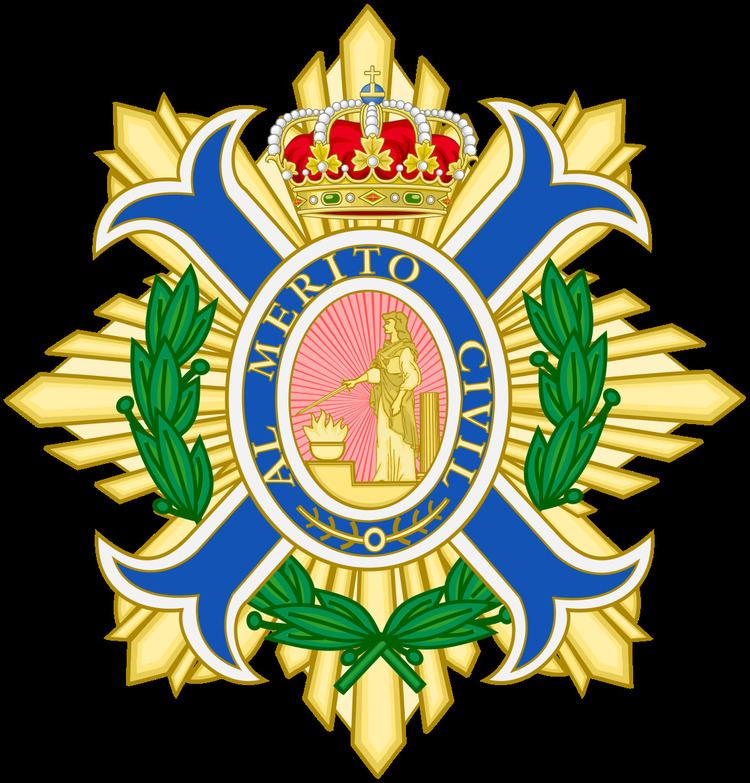Type State Order Status Currently Constituted | Grand Master King Felipe VI | |
 | ||
Awarded for Service to the State, the Provinces and Municipalities Grand Chancellor José García-Margallo y Marfil, Minister of Foreign Affairs | ||
The Order of Civil Merit (Spanish: Orden del Mérito Civil) was established by King Alfonso XIII of Spain in 1926. The order recognizes "the civic virtue of officers in the service of the Nation, as well as extraordinary service by Spanish and foreign citizens for the benefit of Spain."
Contents
History
'According to Basic Norms on Protocol & Decorations
The Order of Civil Merit was established by King Alfonso XIII of Spain, by Royal Decree on 25 June 1926, after a proposition of the President of the Council of Ministers, General D. Miguel Primo de Rivera (1870–1930). Its first Rule was published next 25 May 1927.
This Order was created to prize the civic virtues of the functionaries in service for the State, the Provinces and Municipalities, as well as extraordinary services performed by Spanish citizens for the good of Nation, and could possibly be awarded, moreover, to foreign citizens by courtesy or reciprocity.
At the origin, it consisted of four categories: Grand Cross Commander by Number Commander and Knight Silver Cross (lower rank)
The integration into the Order was conceded by the King, upon proposition of the Minister of State, requiring the agreement of the Council of Ministers when it concerned the concession of the Grand Cross, instructing them in all cases a demonstrative record of the justification of the award and issuing appointments and diplomas by the Section of Foreign Ministry and Orders of the Ministry of State.
The Provisional Government of the Republic, by decree of 24 July 1931, abolished this order and other orders of the Ministry State, except that of Isabel the Catholic, and wanted to replace them with the creation of the Order of the Republic.
Saved this interregnum, by Decree of 7 November 1942 restores the Order of Civil Merit, with his previous features, privileges and seniority, with the following categories: Grand Cross, Cordon (designation of the Grand Cross when given to women), Commander of Number, Commander, Officer, Knight, Knot (name of degree Knight when given to women) and Silver Cross, approving its rules by decree of 3 February 1945.
Subsequently, by decree of 26 July 1957, the Knight of the Collar category is established in the Order of Civil Merit, as the highest distinction of the Order. This high level is reserved to decorate Sovereigns and Heads of State and, exceptionally, to those, enjoying relevant significance, who are already in possession of the Grand Cross of the Order.
The great changes since that date, both in the social and political reality of Spain, and in the legal and administrative system, have been advised to update the rules governing the Order respecting the spirit that inspired its creation and preserving its seniority and their order of priority among the other Spanish Orders.
Thus, by Royal Decree 2.396/1998 of 6 November 1998, published in the Boletín Oficial del Estado 279 of 21 November 1998 (and subsequent correction published in the BOE 40 of 16 February 1999), the approval of the new Rules of Order proceeded, bringing together in one legal text all regulations which were scattered.
Among the most notable elements of the new regulation, one may mention suppression of the names of the degrees of Lady's Cordon, Knight's Cross and Dame's Knot, joining the first in that of Grand Cross, and creating the degree of Cross, including the two others, to avoid interpretations that would consider the maintenance of these designations may involve some form of discrimination based on gender.
Furthermore, it empowers the decorated women, for aesthetic and functional reasons (given the characteristics of their gala dress), to use a shortened version of the insignia, and hang them differently from the men, as specified for each grade in the new regulation.
Two new forms of badges in the degree of Commander were regulated to grant awards to juridical persons: the Tie, for institutions that have recognized the use of flags or similar ensigns, and the Badge of Honour for institutions that do not possess these emblems.
Finally, in order to lend prestige to the distinctions of this Order and ensure that each is properly justified, the current regulation makes a detailed discussion of the merits to be considered for grant, of formal requirements to be met by proposals for entry and promotion within the Order, stating the legitimate authorities to do them, and reporting procedures that can be instructed in order to determine the suitability of granting.
Grades
The ribbon of the order is blue with a narrow white centre stripe, except for the ribbon of "Collar", which is blue with 2 white stripes on the edges.
The Order of Civil Merit comes in seven classes as follows:
Notable recipients
The Collar and Grand Cross of the Order have been awarded to royalty, heads of state and their spouses, and diplomats, including:
